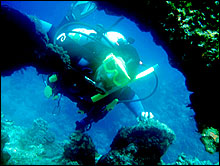Archives
Lewis dives into new research career
UB graduate, research technician returns to school after raising three children
By DONNA BUDNIEWSKI
Reporter Assistant Editor
Slogging through bioinformatics and statistics classes after raising three children doesn't appeal to most people, but Cynthia L. Lewis isn't like most people. A master diver for three years, Lewis decided to turn recreational diving and an interest in marine life into a career as a research diver.
"It's been a challenge. I had to take statistics during the first two semesters when the only math I'd done for a long time was balance a checkbook, but I got through it and actually use it in my work. Bioinformatics was also quite a struggle," Lewis says.

Cynthia Lewis diving at the Great Barrier Reef in Australia. Lewis treated herself to the trip as a reward for completing the master's program in biological sciences at UB.
Her efforts have paid off. A research technician at UB, Lewis is studying the symbiotic relationship between coral and zooxanthellae, a single-cell photosynthetic algae. She also is first author on a paper that recently appeared in the prestigious journal Science—no small feat for someone who just the previous spring had completed a master's degree in biological sciences. (For more information about the Science article, go to http://www.buffalo.edu/reporter/vol35/vol35n37/articles/ CoralStudy.html .)
Lewis tried to ease into the graduate program in biology by taking a field ecology class and auditing a tropical marine ecology class, but Mary Alice Coffroth, associate professor of biological sciences and co-author with her on the Science paper, encouraged Lewis to take the marine ecology class for credit. "The best day of my life was the day I met Mary Alice. She really is a fabulous mentor," says Lewis, who works in Coffroth's laboratory. Coffroth and Howard Lasker, professor of biological sciences, wrote letters of recommendation for Lewis' application to the graduate program in biological sciences.
"I had to take the GRE again and classes in the hard sciences, but I overcame any obstacles because I was already focused on a goal and dedicated to this new career. My husband and children were all very supportive. I think I studied a lot harder and more effectively than in my undergraduate years, but the other students welcomed me and gave me a hand when I needed it," says Lewis. Not only did she burn the midnight oil doing homework again, but worked as a graduate assistant teaching ecological methods and cell biology. Her current research focuses on how some coral can recover from potentially deadly bleaching events caused by environmental stress.
After earning a bachelor's degree in animal science from Cornell University, Lewis worked at the university as a parasitologist for the New York State Diagnostic Laboratory. Two of her children are pursuing degrees in veterinarian medicine at Cornell.
Having dived the Great Lakes region, the powerful currents of the Niagara River and the Caribbean, Lewis says she began looking for academic programs to further her interest in the underwater world she was discovering and was surprised to find that what she was looking for was available at UB. As a master diver, Lewis had to pass a physical exam, log over 150 hours of dive time and must maintain current CPR, first aid and oxygen delivery certification. She also had to pass a physical—all of which qualified her to participate in UB's American Academy of Underwtaer Sciences (AAUS) research diving program.
This fall, she will head to the Florida Keys as a research diver to witness a coral spawning event and collect some of the new polyps to bring back to Coffroth's research lab. "I really enjoy research diving, says Lewis. "This particular coral spawns near midnight during a new moon—it's an incredible sight," she notes.
"To watch tiny gamete packets rising in a pink cloud from the parent colony and swirling up thru the water—all perfectly synchronized—made it a glorious night out on the ocean," says Lewis.
"Under the microscope, the minute newly-formed coral polyps look like little snowflakes," she adds.
Lewis says she likely will study coral the rest of her life and believes in quietly educating people about the importance and vulnerability of the coral reefs through her research.
"The reefs that the hard coral build upon are important in many ways—they protect shores from wave and water action, and are a vital ecosystem for the birth and growth of fish and plant life. Reefs are important to the health of the oceans," says Lewis.
As a gift to herself for getting through the master's program, Lewis traveled to Australia to dive the Great Barrier Reef.
"It was fantastic, with very different textures and colors, in coral and fish, than I've seen in the Caribbean. The Great Barrier Reef is a magnificent kaliedosope of natural shapes, forms and colors—I felt like I was suspended within a piece of artwork," says Lewis.
As for being first author on a research paper, "It's pretty amazing," she says. "It was Mary Alice's project, based on questions she had. It was her idea. A lot of people worked on different pieces of the total project. I just got lucky."
